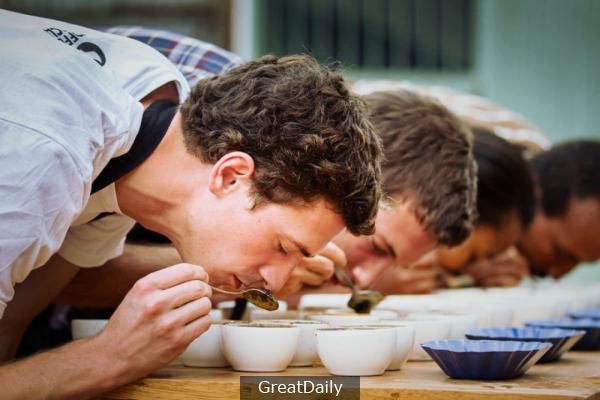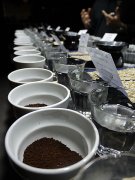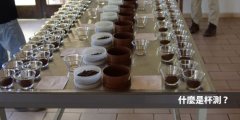The correct coffee cup test procedure of coffee knowledge how to break the powder correctly in coffee cup test?

Professional coffee knowledge exchange more coffee bean information please follow the coffee workshop (Wechat official account cafe_style)
Why is the coffee grindability standard measured by the cup so important? What is the grinding degree of the standard cup?
Coffee cup test, English called coffee cupping, also known as coffee tasting. It is a very magical and simple method for sensory evaluation of coffee. The quality of coffee is judged by the sense of taste, which is called "coffee cup test". When testing the cup, make the coffee flow back and forth in your mouth and make full use of your sense of taste and smell to feel the flavor characteristics of the coffee. It transforms the subjective and different sensory experience into quantitative data with practical value to guide people's practical decisions, such as buying, selling, sharing experience and so on. Anyone can participate, but the coffee cup tester uses a more professional scoring form to evaluate each cup of coffee and rate the coffee.
The tools needed for cup testing are simple: bean grinders, electronic scales, thermometers, cups, spoons, timers, such simple tools can be found on coffee farms, and cup tests can be done on coffee fields.
Many values for brewing coffee are quantified: the grindability of the coffee powder, the weight of the coffee and the temperature are all quantified uniformly to ensure that each cup of coffee on the cup test table is brewed under the same conditions.
Coffee cup test of coffee knowledge (step)
Note that roasted coffee must be kept for one or two days. If you buy coffee outside, find a regular roaster so that you can contact them to order samples of coffee baked on the same day.
In the industry chain of the coffee industry, there are several types of people who need to do cup testing:
Bean traders use cup tests to understand the quality of coffee raw beans as the basis for transactions. in the trade of boutique coffee, the taste in the cup determines the price of coffee.
Coffee roaster, through cup measurement to determine the roasting degree of coffee and the quality control of coffee products.
In addition, even careful coffee shop owners will use cup tests to select suppliers.
Enthusiasts can also compare and understand the taste of several coffee beans through cup testing.
Prepare for
When taking a cup test, you have to record all your thoughts at that time. Because taste is a feeling with a very short memory time, you may not remember it at all later. At the beginning of learning, there is no need to rush to record, at this time your feelings are not very clear and accurate. First, through a period of practice, and communicate with experienced people, learn the description of taste and taste, and then start to record your feelings.
Prepare a spacious space, which can be a large kitchen or dining room, to facilitate people to walk around and record. It is recommended to use "cup meter".
Put all the tools on the table, and if you want to test several different kinds of coffee, make a set of tools for each kind of coffee. Prepare 5 cups of ice water 3murmur5 cups according to the number of people tested.
Steps
1. Measure a certain amount of coffee beans and put them in a container. Be sure to remember what variety is in each cup and don't get mixed up. The name of the coffee can be recorded with a self-adhesive label and affixed to the bottom of the container. After tasting, you can check and confirm the variety of the coffee.
At this time, you can start to heat hot water. When everything was ready, the water boiled. Be sure to use fresh pure water.
3. Grind each different kind of coffee beans separately and make sure to clean up the coffee powder left by the grinder before replacing the beans. Here according to your own habit to choose automatic or manual bean grinder, preferably an automatic bean grinder, magic beans for a long time is easy to cause aroma loss.
Get rich healthily 300x186-270
4. grind the coffee beans as soon as possible, so as not to lose too much aroma of coffee over a long time. Rearrange the table. The method of "blind test" is generally adopted. If you are not going to use the "blind test" method, you can put the packing bag of each coffee sample behind the corresponding tasting cup.
5. Many cup testers use the time before boiling hot water to observe and smell the smell of coffee powder. For beginners, this is not a necessary step.
6. After the hot water is boiled, turn off the power and check the temperature with a thermometer. When flushing, the water temperature should be 82murmur92 degrees. Choose according to your grinding degree. Grind the water temperature a little lower, and vice versa. Then pour the boiling water into the coffee powder in a circle from the inside to the outside, then pour in 70--80cc for steaming. Smell the coffee at the same time.
7. Then continue to add water to a certain amount, according to the previously established ratio of water to powder. Add hot water in the order of grinding. Here, pay attention to slowly and evenly inject hot water, do not let any part of the coffee powder agglomerate. Also pay attention to the control of hot water, neither too much nor too little, otherwise it will affect the taste of coffee.
8. Record the time immediately after adding hot water. Wait a few minutes before you can start evaluating the coffee.
9. The cup test begins: put your face close to the coffee cup, use the cup spoon to put the "crust" on the coffee surface to the opposite side, and "smell the incense" with your nose.
10. Taste every kind of coffee sample in the same way. If you taste it alone, prepare two cups of each coffee sample, and each cup should be tasted in this way. If several people taste it together, each person can taste it once, but the intermediate process should not take too long, otherwise the temperature difference when everyone tastes is too big, the taste will be different.
11. Use two cup spoons to dig out the crust around the cup wall (from front to back). Be careful not to dig up too much coffee.
12. Rinse your mouth with ice water and clean your brain at the same time, forget all feelings for a while and prepare for the next step.
13. Start tasting the coffee, put a spoon of the coffee liquid in a cup spoon, and then "quickly inhale" into your mouth. The aim is to "spray the coffee liquid into the mouth" to cover the whole mouth and release the fragrance of the coffee liquid as much as possible. This method is similar to that of wine tasters, and the reason is also similar.
14. Note that every time you change a cup of coffee sample, the cup spoon should be cleaned and rinsed with ice water to avoid affecting each other's taste.
15. in the same way, taste each cup of coffee sample several times until the temperature of the coffee sample drops to room temperature. Be careful to forget the previous feeling as much as possible before each coffee taste, so as to experience the next coffee sample with the purest feeling.
16. In the process of tasting coffee, you can spit out most of the coffee liquid. But swallow at least a small part in order to experience the feeling of the coffee sample.
Matters needing attention
During the cup test, the tester should keep quiet until everyone has finished the tasting process. Because one person's feelings and opinions may disturb others.
Be careful to gargle with ice water, otherwise the last coffee flavor will affect your correct judgment of the next one.
At the end of the tasting process, everyone recorded their feelings and thoughts. Only then can we begin to discuss and even debate the advantages, disadvantages and characteristics of all kinds of coffee.
Pay attention to your own feelings and experiences, as well as the similarities and inconsistencies with other people's feelings and experiences, and the way and vocabulary in which you and others describe various taste characteristics.
.
Important Notice :
前街咖啡 FrontStreet Coffee has moved to new addredd:
FrontStreet Coffee Address: 315,Donghua East Road,GuangZhou
Tel:020 38364473
- Prev

The significance of coffee cup test score what is the basis of coffee cup written test score?
Professional coffee knowledge exchange more coffee bean information please follow the coffee workshop (Wechat official account cafe_style) cup coffee grindability standard why is it so important? What is the grinding degree of the standard cup? The cup test is a way to test the quality of the coffee, and the score after the cup test represents the cup tester's evaluation of the coffee. In the producing countries, buying coffee with farmers is
- Next

Coffee cup test thinking | does the size of coffee beans affect the coffee cup test score?
Professional coffee knowledge exchange more coffee bean information please follow the coffee workshop (Wechat official account cafe_style) cup coffee grindability standard why is it so important? What is the grinding degree of the standard cup? Believe this question, as a coffee fan, you must have been curious for a long time! If we put the same roasted batch but different sizes of coffee into the cup and grind it for the cup.
Related
- Detailed explanation of Jadeite planting Land in Panamanian Jadeite Manor introduction to the grading system of Jadeite competitive bidding, Red bid, Green bid and Rose Summer
- Story of Coffee planting in Brenka region of Costa Rica Stonehenge Manor anaerobic heavy honey treatment of flavor mouth
- What's on the barrel of Blue Mountain Coffee beans?
- Can American coffee also pull flowers? How to use hot American style to pull out a good-looking pattern?
- Can you make a cold extract with coffee beans? What is the right proportion for cold-extracted coffee formula?
- Indonesian PWN Gold Mandrine Coffee Origin Features Flavor How to Chong? Mandolin coffee is American.
- A brief introduction to the flavor characteristics of Brazilian yellow bourbon coffee beans
- What is the effect of different water quality on the flavor of cold-extracted coffee? What kind of water is best for brewing coffee?
- Why do you think of Rose Summer whenever you mention Panamanian coffee?
- Introduction to the characteristics of authentic blue mountain coffee bean producing areas? What is the CIB Coffee Authority in Jamaica?

